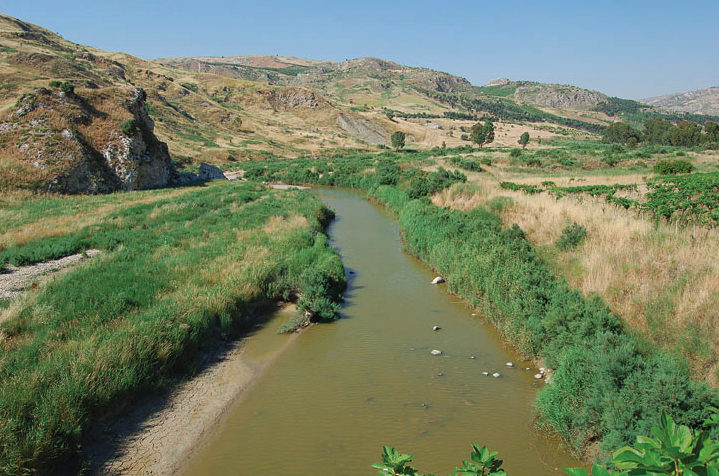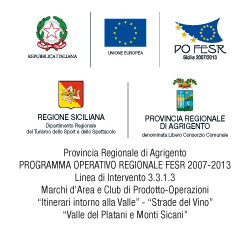
Historians say that the evolution of a people, the great civilizations, of a territory, is faster when there is the presence of seas, rivers, navigable rivers in general. This is because often the "waters" enable the discovery of new lands and facilitate the integration of the peoples. Even the river Platani, the cradle of civilization indigenous to Sicana, is a waterway that has contributed in a small way as a very important element in the process of spreading the human presence in the south-central Sicily. The Platani begins its journey in the territory of Castronovo di Sicilia, in Portella di Mola, through a winding course, which winds through the provinces of Palermo, Agrigento and Caltanissetta, to reach, after a journey of 115 km, near Eraclea Minoa, where the river empties into the Mediterranean Sea.
There are many municipalities affected by the river route, the most important include Cammarata, Mussomeli, Casteltermini, Aragon and Ribera. It flows in an open valley snaking in a rich tapestry of meanders. From its sandy bottom and its brackish waters you can see the presence of salt. Its route, in general, can be identified in three segments, which respectively define the upper, middle and lower reaches of Platani. The variety of landscapes created by the different aspects of the river, by expanding or contracting in the valley through the narrow gorges carved in the rock, is certainly one of the components of its beauty. Fortunately, the Platani still conserves the enchantment of the river Mediterranean, with typical flora of briny habitats, for long stretches, along its entire length.
The river flow varies depending on the seasons; in the rainy season, which usually falls in the period between November and February, the flow increases significantly, reaching points of 1,500 cubic meters per second; in the summer, however, the river drastically reduces its scope, and has sometimes been registered at minimum values of 0,03 cubic meters per second. So, you can imagine the appearance of the river can vary considerably, from one season to another, from a regime of lean summer to one of full winter, which determines considerable changes of the system of flora and fauna. The landscape surrounding the river is very impressive and varied and offers the ability to capture in a single synthesis its various aspects: Monte Cammarata (that rises steeply to over 1500 m), where you can admire one of the largest and superb views of the Sicily; the rugged hills and whitish gypsum crystal scattered along the middle of the Platani, the meanders designed by the river, the villages perched on the cliffs with their glorious history, the almond trees in bloom in the first warm days of Spring, and more .
All this is, on the whole, the natural, historical and cultural heritage, make the river Platani unique in Sicily. The Platani, in fact, is not only a valuable environmental resource, but also represents a historical reference - of great archaeological value.
The valley of the Platani was the cradle of civilization, dating back to the Neolithic period, the most important of which was the Sicani, an ethnic unity that goes back to the early history of central and western Sicily.They found a comfortable settlement in the valley of Platani due to the presence of the river, navigable up until Roman times, and for the presence of salt along the sides of the valley, that was a very good product for trade. Sican populations practiced agriculture and pastoralism, lived in small communities in the hills and in places that nature made it difficult to access.
In one of these places took place the legendary story of Daedalus, who, after escaping from Crete after designing the construction of the infamous Maze, arrived in Sicily and was hosted by King Cocalo. Daedalus, in debt for the hospitality received, built a city on a steadfast hill that made it safe from any enemy attack. It was the legendary Camico. Today, according to some experts, it is believed to arise near the hill of Sant'Angelo Muxaro, theories supported by the presence of the suggestive necropolis of San Angelo.
The valley of the Platani retains signs of mining history that since the nineteenth century interested inland areas of Sicily. There are numerous abandoned mines present in the vicinity of the river - most importatntly the sulfur mine "Cozzo Disi", in territory of Casteltermini. Within which occurred the drama of "Carusi Siciliani", teenagers who were forced to work in inhuman conditions and were often victims of violence and harassment by adults.
The mouth of the Platani is the only part environmentally protected. For several years it has been established that an area of nature reserve aims to protect its native species of flora and fauna. The river Platani, in fact, represents an excellent ecological corridor for the resting and nesting of many species of birds during migration. Among migratory species, so far observed, we can mention the Curlew (increasingly rare due to non-environmentally friendly agriculture), The Grey Heron, the Great Egret and the Knight of Italy.
Following the path towards the African sea you arrive at the mouth of the river. Nature reserve of charming beauty falls within the cities of Ribera and Cattolica Eraclea, up towards the beach of Borgo Bonsignore and the promontory of Capo Bianco. The ancient city of Heraclea Minoa sits majestically on a plateau to the east of the mouth. Home to a colony of Selinunte, from the sixth century B.C., it was fought over by Akragas and Selinunte and later by the Carthaginians and Romans. After a long succession of destruction and rebuilding, the city was abandoned in the late first century B.C. The excavations have uncovered its walls and its doors. The village of the Hellenistic period (IV -I sec. A. C.) and its exhibits are a very important part in the antiquarium of Minoa and the Archaeological Museum of Agrigento. The beautiful amphitheater with its steps opening to the South confirms the magnificence of ancient Minoa.



